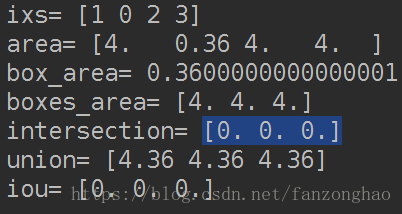正常矩形计算IOU与与NMS,多边形计算IOU
一.计算IOU
def intersect(box_a, box_b):
max_xy = np.minimum(box_a[:, 2:], box_b[2:])
min_xy = np.maximum(box_a[:, :2], box_b[:2])
inter = np.clip((max_xy - min_xy), a_min=0, a_max=np.inf)
return inter[:, 0] * inter[:, 1]
def jaccard_numpy(box_a, box_b):
"""Compute the jaccard overlap of two sets of boxes. The jaccard overlap
is simply the intersection over union of two boxes.
E.g.:
Args:
box_a: Multiple bounding boxes, Shape: [num_boxes,4]
box_b: Single bounding box, Shape: [4]
Return:
jaccard overlap: Shape: [box_a.shape[0], box_a.shape[1]]
"""
inter = intersect(box_a, box_b)
area_a = ((box_a[:, 2]-box_a[:, 0]) *
(box_a[:, 3]-box_a[:, 1])) # [A,B]
area_b = ((box_b[2]-box_b[0]) *
(box_b[3]-box_b[1])) # [A,B]
union = area_a + area_b - inter
return inter / union # [A,B]人工修正后的每一个框与算法输出的所有框去计算IOU,取出IOU大于0.9的算法输出框
def compute_IOU(algrim_bboxs,fix_bboxs):
# print('algrim_bboxs:', algrim_bboxs)
# print('fix_bboxs:', fix_bboxs)
for i, fix_bbox in enumerate(fix_bboxs):
print('fix_bbox:', fix_bbox)
fix_x1, fix_y1, fix_x2, fix_y2 = fix_bbox
x1, y1, x2, y2 = algrim_bboxs[:,0], algrim_bboxs[:,1], algrim_bboxs[:,-2], algrim_bboxs[:,-1]
area = (y2-y1)*(x2-x1)
inter = np.maximum((np.minimum(x2,fix_x2) - np.maximum(x1,fix_x1)),0)*np.maximum((np.minimum(y2,fix_y2) - np.maximum(y1, fix_y1)),0)
union = area+(fix_y2-fix_y1)*(fix_x2-fix_x1)-inter
IOU = inter/union
# print('IOU:', IOU)
index = np.where(IOU > 0.9)[0]
print('algrim_bboxs[index]:', algrim_bboxs[index])
注释:下面的代码假设了第0行是IOU最大的,那么其余做NMS计算
boxes=np.array([[1,2,3,4],
[5,6,7,8],
[9,10,11,12]])
y1 = boxes[:, 0]
x1 = boxes[:, 1]
y2 = boxes[:, 2]
x2 = boxes[:, 3]
area = (y2 - y1) * (x2 - x1)
print('area=',area)
box_area=area[0]
print('box_area=',box_area)
boxes_area=area[1:]
print('boxes_area=',boxes_area)
box=boxes[0]
y1 = np.maximum(box[0], boxes[1:, 0])
y2 = np.minimum(box[2], boxes[1:, 2])
x1 = np.maximum(box[1], boxes[1:, 1])
x2 = np.minimum(box[3], boxes[1:, 3])
#注意与0判断 若不想交返回0值,即intersection为0
intersection = np.maximum(x2 - x1, 0) * np.maximum(y2 - y1, 0)
print('intersection=',intersection)
union = box_area + boxes_area - intersection[:]
print('union=',union)
iou = intersection / union
print('iou=',iou)二,一般加上score,这样用
scores = np.array([0.5, 0.7, 0.3, 0.2])
ixs=scores.argsort()[::-1]
print('ixs=',ixs)
boxes=np.array([[1,2,3,4],
[1.2, 0.4,2.1, 0.8],
[5,6,7,8],
[9,10,11,12]])
y1 = boxes[:, 0]
x1 = boxes[:, 1]
y2 = boxes[:, 2]
x2 = boxes[:, 3]
area = (y2 - y1) * (x2 - x1)
print('area=',area)
box_area=area[ixs[0]]
print('box_area=',box_area)
boxes_area=area[ixs[1:]]
print('boxes_area=',boxes_area)
box=boxes[ixs[0]]
boxes=boxes[ixs[1:]]
y1 = np.maximum(box[0], boxes[:, 0])
y2 = np.minimum(box[2], boxes[:, 2])
x1 = np.maximum(box[1], boxes[:, 1])
x2 = np.minimum(box[3], boxes[:, 3])
#注意与0判断 若不想交返回0值,即intersection为0
intersection = np.maximum(x2 - x1, 0) * np.maximum(y2 - y1, 0)
print('intersection=',intersection)
union = box_area + boxes_area - intersection[:]
print('union=',union)
iou = intersection / union
print('iou=',iou)三,求其NMS后的框的小trick
scores=np.array([0.8,0.4,0.7,0.2,0.5])
ixs = scores.argsort()[::-1]
print('ixs=',ixs)
#iou要比score少一个数值,因为iou的计算是由score的第一个值确定的,故下面的np.where要加1
iou=np.array([0.3,0.6,0.1,0.4])
threshold=0.3
remove_ixs = np.where(iou > threshold)[0]+1
print('remove_ixs=',remove_ixs)
# Remove indices of the picked and overlapped boxes.
ixs = np.delete(ixs, remove_ixs)
print('ixs=',ixs)
ixs = np.delete(ixs, 0)
print('ixs=',ixs)四,加入while,就把不要的框删掉
scores = np.array([0.8, 0.4, 0.7, 0.2, 0.5])
ixs = scores.argsort()[::-1]
while len(ixs) > 0:
print('================================')
print('ixs=', ixs)
# iou要比score少一个数值,因为iou的计算是由score的第一个值确定的,故下面的np.where要加1
iou = np.array([0.3, 0.6, 0.1, 0.4])
threshold = 0.3
remove_ixs = np.where(iou > threshold)[0] + 1
print('remove_ixs=', remove_ixs)
# Remove indices of the picked and overlapped boxes.
ixs = np.delete(ixs, remove_ixs)
print('ixs=', ixs)
ixs = np.delete(ixs, 0)
print('ixs=', ixs)五,faster rcnn NMS
def py_cpu_nms(dets, thresh):
"""Pure Python NMS baseline."""
x1 = dets[:, 0]
y1 = dets[:, 1]
x2 = dets[:, 2]
y2 = dets[:, 3]
scores = dets[:, 4]
areas = (x2 - x1 + 1) * (y2 - y1 + 1)
order = scores.argsort()[::-1]
print('order',order)
keep = []
while order.size > 0:
i = order[0]
keep.append(i)
xx1 = np.maximum(x1[i], x1[order[1:]])
yy1 = np.maximum(y1[i], y1[order[1:]])
xx2 = np.minimum(x2[i], x2[order[1:]])
yy2 = np.minimum(y2[i], y2[order[1:]])
w = np.maximum(0.0, xx2 - xx1 + 1)
h = np.maximum(0.0, yy2 - yy1 + 1)
inter = w * h
ovr = inter / (areas[i] + areas[order[1:]] - inter)
print('ovr=',ovr)
print('np.where(ovr <= thresh)',np.where(ovr <= thresh))
inds = np.where(ovr <= thresh)[0]
print('inds=',inds)
print('inds + 1',inds + 1)
print('order[inds + 1]',order[inds + 1])
order = order[inds + 1]
print('order=',order)
return keep
def nms():
# ###self nms
result = [np.array([[7.9301813e+02, 6.3052429e+02, 8.9795898e+02,
7.2513965e+02,9.9307442e-01],
[8.0682990e+02, 6.4606281e+02, 8.7198071e+02, 7.1328979e+02,
9.5732883e-02]], dtype=np.float32)]
##faster rcnn nms
keep=py_cpu_nms(result[0],0.3)
print('keep=',keep)
for i in keep:
print('i=',i)
print(result[0][i])此处大于0.3的IOU就抑制
六.多边形利用polygon计算IOU
def compute_IOU_():
import numpy as np
import shapely
from shapely.geometry import Polygon, MultiPoint # 多边形
path = './134.jpg'
img = cv2.imread(path)
print('img.shape:', img.shape)
line1 = [728, 252, 908, 215, 934, 312, 752, 355] # 四边形四个点坐标的一维数组表示,[x,y,x,y....]
line2 = [741, 262, 907, 228, 923, 308, 758, 342]
# #debug to show
# line1 = np.array(line1).reshape(4, 2)
# line2 = np.array(line2).reshape(4, 2)
# cv2.polylines(img, [np.array(line1).reshape(-1, 1, 2)], True, (0, 255, 0), thickness=2)
# cv2.polylines(img, [np.array(line2).reshape(-1, 1, 2)], True, (0, 0, 255), thickness=2)
# cv2.imwrite('134_with_rect.jpg',img)
line1_box = np.array(line1).reshape(4, 2) # 四边形二维坐标表示
# 凸多边形
# poly1 = Polygon(line1_box).convex_hull
#凸多边形与凹多边形
poly1 = Polygon(line1_box)#.convex_hull # python四边形对象,会自动计算四个点,最后四个点顺序为:左上 左下 右下 右上 左上
print(Polygon(line1_box).convex_hull)
line2_box = np.array(line2).reshape(4, 2)
# 凸多边形
# poly2 = Polygon(line2_box).convex_hull
# 凸多边形与凹多边形
poly2 = Polygon(line2_box)
print(Polygon(line2_box).convex_hull)
union_poly = np.concatenate((line1_box, line2_box)) # 合并两个box坐标,变为8*2
# print(union_poly)
print(MultiPoint(union_poly).convex_hull) # 包含两四边形最小的多边形点
if not poly1.intersects(poly2): # 如果两四边形不相交
iou = 0
else:
try:
inter_area = poly1.intersection(poly2).area # 相交面积
print(inter_area)
union_area = MultiPoint(union_poly).convex_hull.area
print(union_area)
if union_area == 0:
iou = 0
# iou = float(inter_area) / (union_area-inter_area) #错了
iou = float(inter_area) / union_area
except shapely.geos.TopologicalError:
print('shapely.geos.TopologicalError occured, iou set to 0')
iou = 0
print('line1_box:', line1_box)
print('iou:', iou)







